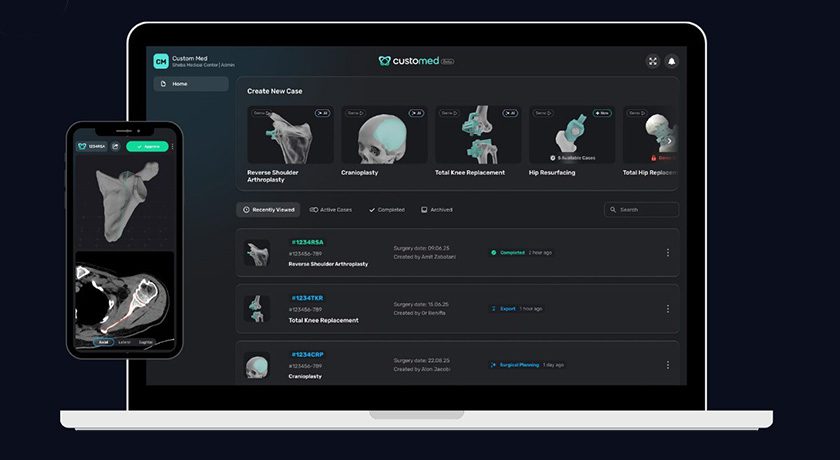

 Copy to clipboard
Copy to clipboard 
Johnson & Johnson MedTech is getting out of the orthopedics business. Along with its third quarter earnings, the company announced it plans to spin off its orthopedic business units within two years to create a standalone company named DePuy Synthes.
Perhaps the only surprising aspect of the announcement is that it took the company so long to pull the trigger. J&J MedTech created a behemoth by combining its 1998 acquisition of DePuy and its 2012 acquisition of Synthes.
But in the modern era, say the last 10 years, the enterprise has proven unwieldy and slow to adapt to changing market conditions as its competitors redefine the paradigm of orthopedic care.
Below we’ll look at how we got to this point and speculate a bit about what the future may hold for the new DePuy Synthes.
The Line Must Go Up
This move has little to do with orthopedics, innovation, or patients. It is about jettisoning an underperforming and, at times, mismanaged business to make growth numbers look better to investors. J&J MedTech said it will shift its focus to areas of greatest unmet need and growth, like cardiovascular and robotic surgery.
“This decision to separate Ortho is the next major step in that direction,” said Tim Schmid, J&J MedTech Executive Vice President of MedTech. “Ortho is a great business, but frankly, one that participates in lower-growth markets. This is all about shrinking to grow faster for MedTech. And last time I looked, [Wall Street] is not rewarding size, but rather best-in-class performance, and that’s the path that we’re on. We expect the separation will increase our top line growth and margins following the completion.”
The company is correct that orthopedics contains some lower growth markets, but its competitors like Stryker, Enovis, ATEC and Medacta have shown that true innovation can drive substantial growth even in the most mature markets.
J&J MedTech CFO Joe Wolk expects that DePuy Synthes will have a strong capital structure post-separation that will allow it to build on “its long history of innovation” through organic investment and strategic M&A.
A Decade of Treading Water
While orthopedics had some good moments at J&J MedTech, there’s scant evidence of a long history of innovation. As of the end of 2024, the company surrendered its market leadership position to Stryker and saw Zimmer Biomet, a company with its own set of challenges, gain ground. On a more granular, per-segment level the company has been besieged by a host of smaller but more innovative challengers.
Top 3 Players Total Sales 2016 – 2024
J&J MedTech’s orthopedics business has a 10-year CAGR of just 0.1%. Looking deeper into the company’s performance over that span, there are plenty of trouble spots.
Its Sports, Spine & Other business unit was getting eaten alive even before the pandemic and has done little to turn the tide since. It’s 10-year CAGR is -2.8%. Likewise, the company has been stuck in neutral for knee replacement during a time when its competitors have driven impressive growth with technology.
In fairness, J&J MedTech has done better in hip replacement and trauma, with 2.3% and 2.2% 10-year CAGRs respectively.
J&J MedTech Orthopedic Sales by Segment 2016 – 2025E
While the company’s U.S. performance isn’t exactly noteworthy (0.5% CAGR), its inability to grow outside the U.S. (-0.6% CAGR) is somewhat surprising given its massive global footprint and established presence in key markets.
Certainly, global markets have been choppy in recent years, especially Asia Pacific. But it is hard to think of a company better suited to weather those conditions than J&J MedTech.
“We were one of the first companies that started to operate in China, and we’ve been in China for decades,” said J&J MedTech CEO Joaquin Duato. “We have a history of having constructive engagements with China, and we are looking forward for that to continue. We have robust business continuity planning practices in place, and we can mitigate any potential exposure. We continue to see China as an important growth driver, both for our Innovative Medicine business and for our MedTech business.”
As it turns out, only the company’s OUS knee replacement business has had a modicum of success, for reasons we’ll cover in a moment.
J&J MedTech OUS Orthopedic Sales by Segment 2016 – 2025E
Building Blocks for DePuy Synthes
So, what is working for J&J MedTech’s orthopedics business? Even though it was late to the enabling technology game, the VELYS robotic platform and surrounding ecosystem has provided tailwinds for the company in knee replacement, especially outside the United States.
The platform received CE and CA Mark international approvals in mid-2023. By early 2025, VELYS had racked up 110,000 procedures across 30 countries.
“We had some gaps in the past and now filling those gaps both in hips and then even more notably in knees with the launch of our VELYS robot is really what is creating the tailwind that we’re enjoying today. Can we see that sort of growth every single quarter? I’m not sure, but we do expect high single-digit growth out of both of those categories going forward,” said Mr. Wolk.
While durable high-single-digit growth didn’t materialize for the company, VELYS represents a nice building block for standalone DePuy Synthes in joint replacement and possibly spine.
In trauma, the company’s VOLT Plating System and TriLEAP Lower Extremity Plating System closed some lingering portfolio gaps and helped drive improved performance in the segment.
A Hard Road Ahead
At the risk of drawing too direct a comparison between this move and the ZimVie situation, the spin for these moves is always the same. More focus. More investment. More innovation. And I think DePuy Synthes will emerge from this as a more focused company with a chance to be more competitive. Eventually.
It would be foolish to imagine DePuy Synthes will just hit the ground running after changes of this magnitude. We don’t expect any substantial news about the spin-off from J&J MedTech for at least several months, but uncertainty among stakeholders from sales reps to surgeons to suppliers could create some early impacts.
Even after the separation, the issues we outlined above will remain. It is too early to speculate about portfolio or market management, but would anyone be shocked to see DePuy Synthes get out of the spine segment? Could we see a contraction of its global footprint?
The only sure thing is it will take more than two years for all of these impacts to shake out, and by that time the orthopedic landscape could look very different.
Johnson & Johnson MedTech is getting out of the orthopedics business. Along with its third quarter earnings, the company announced it plans to spin off its orthopedic business units within two years to create a standalone company named DePuy Synthes.
Perhaps the only surprising aspect of the announcement is that it took the company so...
Johnson & Johnson MedTech is getting out of the orthopedics business. Along with its third quarter earnings, the company announced it plans to spin off its orthopedic business units within two years to create a standalone company named DePuy Synthes.
Perhaps the only surprising aspect of the announcement is that it took the company so long to pull the trigger. J&J MedTech created a behemoth by combining its 1998 acquisition of DePuy and its 2012 acquisition of Synthes.
But in the modern era, say the last 10 years, the enterprise has proven unwieldy and slow to adapt to changing market conditions as its competitors redefine the paradigm of orthopedic care.
Below we’ll look at how we got to this point and speculate a bit about what the future may hold for the new DePuy Synthes.
The Line Must Go Up
This move has little to do with orthopedics, innovation, or patients. It is about jettisoning an underperforming and, at times, mismanaged business to make growth numbers look better to investors. J&J MedTech said it will shift its focus to areas of greatest unmet need and growth, like cardiovascular and robotic surgery.
“This decision to separate Ortho is the next major step in that direction,” said Tim Schmid, J&J MedTech Executive Vice President of MedTech. “Ortho is a great business, but frankly, one that participates in lower-growth markets. This is all about shrinking to grow faster for MedTech. And last time I looked, [Wall Street] is not rewarding size, but rather best-in-class performance, and that’s the path that we’re on. We expect the separation will increase our top line growth and margins following the completion.”
The company is correct that orthopedics contains some lower growth markets, but its competitors like Stryker, Enovis, ATEC and Medacta have shown that true innovation can drive substantial growth even in the most mature markets.
J&J MedTech CFO Joe Wolk expects that DePuy Synthes will have a strong capital structure post-separation that will allow it to build on “its long history of innovation” through organic investment and strategic M&A.
A Decade of Treading Water
While orthopedics had some good moments at J&J MedTech, there’s scant evidence of a long history of innovation. As of the end of 2024, the company surrendered its market leadership position to Stryker and saw Zimmer Biomet, a company with its own set of challenges, gain ground. On a more granular, per-segment level the company has been besieged by a host of smaller but more innovative challengers.
Top 3 Players Total Sales 2016 – 2024
J&J MedTech’s orthopedics business has a 10-year CAGR of just 0.1%. Looking deeper into the company’s performance over that span, there are plenty of trouble spots.
Its Sports, Spine & Other business unit was getting eaten alive even before the pandemic and has done little to turn the tide since. It’s 10-year CAGR is -2.8%. Likewise, the company has been stuck in neutral for knee replacement during a time when its competitors have driven impressive growth with technology.
In fairness, J&J MedTech has done better in hip replacement and trauma, with 2.3% and 2.2% 10-year CAGRs respectively.
J&J MedTech Orthopedic Sales by Segment 2016 – 2025E
While the company’s U.S. performance isn’t exactly noteworthy (0.5% CAGR), its inability to grow outside the U.S. (-0.6% CAGR) is somewhat surprising given its massive global footprint and established presence in key markets.
Certainly, global markets have been choppy in recent years, especially Asia Pacific. But it is hard to think of a company better suited to weather those conditions than J&J MedTech.
“We were one of the first companies that started to operate in China, and we’ve been in China for decades,” said J&J MedTech CEO Joaquin Duato. “We have a history of having constructive engagements with China, and we are looking forward for that to continue. We have robust business continuity planning practices in place, and we can mitigate any potential exposure. We continue to see China as an important growth driver, both for our Innovative Medicine business and for our MedTech business.”
As it turns out, only the company’s OUS knee replacement business has had a modicum of success, for reasons we’ll cover in a moment.
J&J MedTech OUS Orthopedic Sales by Segment 2016 – 2025E
Building Blocks for DePuy Synthes
So, what is working for J&J MedTech’s orthopedics business? Even though it was late to the enabling technology game, the VELYS robotic platform and surrounding ecosystem has provided tailwinds for the company in knee replacement, especially outside the United States.
The platform received CE and CA Mark international approvals in mid-2023. By early 2025, VELYS had racked up 110,000 procedures across 30 countries.
“We had some gaps in the past and now filling those gaps both in hips and then even more notably in knees with the launch of our VELYS robot is really what is creating the tailwind that we’re enjoying today. Can we see that sort of growth every single quarter? I’m not sure, but we do expect high single-digit growth out of both of those categories going forward,” said Mr. Wolk.
While durable high-single-digit growth didn’t materialize for the company, VELYS represents a nice building block for standalone DePuy Synthes in joint replacement and possibly spine.
In trauma, the company’s VOLT Plating System and TriLEAP Lower Extremity Plating System closed some lingering portfolio gaps and helped drive improved performance in the segment.
A Hard Road Ahead
At the risk of drawing too direct a comparison between this move and the ZimVie situation, the spin for these moves is always the same. More focus. More investment. More innovation. And I think DePuy Synthes will emerge from this as a more focused company with a chance to be more competitive. Eventually.
It would be foolish to imagine DePuy Synthes will just hit the ground running after changes of this magnitude. We don’t expect any substantial news about the spin-off from J&J MedTech for at least several months, but uncertainty among stakeholders from sales reps to surgeons to suppliers could create some early impacts.
Even after the separation, the issues we outlined above will remain. It is too early to speculate about portfolio or market management, but would anyone be shocked to see DePuy Synthes get out of the spine segment? Could we see a contraction of its global footprint?
The only sure thing is it will take more than two years for all of these impacts to shake out, and by that time the orthopedic landscape could look very different.

You’ve reached your limit.
We’re glad you’re finding value in our content — and we’d love for you to keep going.
Subscribe now for unlimited access to orthopedic business intelligence.
ME
Mike Evers is a Senior Market Analyst and writer with over 15 years of experience in the medical industry, spanning cardiac rhythm management, ER coding and billing, and orthopedics. He joined ORTHOWORLD in 2018, where he provides market analysis and editorial coverage.







